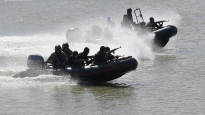Confirmation of NATO membership in the next few weeks will change Finland’s international position and possibly also the spiritual atmosphere of our country. Finland will become a border state of NATO’s new long eastern border, with new rights and obligations.
Together with the experts, we figured out what kind of issues NATO-Finland will be struggling with a week, a month, and a half year after membership is realized.
One week after the confirmation of membership
– We have reached the scope of the fifth article of the NATO charter, which means we have full security guarantees against external attacks. In general, it is the biggest change that membership brings, the head of the Defense Policy Department of the Ministry of Defense Janne Kuusela evaluate.
The fifth article means that the NATO countries will support Finland armedly against any enemy state or group if necessary.
NATO has used Article 5 only once in its 74-year history. It happened after the September 2001 terrorist attacks in the United States.
At that time, NATO was ready to respond with all its strength if the terrorist attacks continued. The United States quickly assembled a broad coalition to support it when it began airstrikes in Afghanistan.
In other cases, a mere glimpse of the fifth article has been enough, because its preventive deterrence is so great.
The Finns have never before had security guarantees that are even close to this. Getting them can quickly affect the atmosphere – or not.
Research doctor at the Institute of Foreign Policy Iro Sarkkä reminds that the weeks after accession in Finland are marked by government negotiations.
– Nothing can be said for sure about the NATO line of the basic Finns, because they have not announced their election program. In general, it can be said that the more right-wing the next government is, the more transatlantic it thinks, while the values of the SDP-led government place more emphasis on European and Nordic cooperation, says Särkkä.
One month from confirmation of membership
The orientation of the new government has an effect, for example, on the implementation of the performance goals set by NATO’s member countries. They are being thought about with full head at the point when a month has passed since Finland’s membership.
NATO has three command centers under which the armed forces of the member countries operate. They are located in Norfolk in the US, Brunssum in the Netherlands and Naples in Italy.
Finland will either join Germany, Poland and the Baltic countries under Brunssum, or under Norfolk, where it would have the United States, Great Britain, Denmark and Norway as partners.
Finland decides for itself which chain to join.
Whether the Finns will hear orders from Brunssum or Norfolk in the future is important, for example, for future defense investments: Brunssum is a land force- and Baltic Sea-focused command structure, while Norfolk is an air- and naval-focused command structure.
The importance of the Norfolk chain will be emphasized in the next few years in the defense of the Arctic regions and the airspace of Northern Europe, while the Brunssum chain will be in the defense of NATO’s eastern fringes.
Full-scale committee work has started. Finns have been observers in NATO’s planning committees since the summer of 2022, but now they also get to participate in decision-making.
As a member, Finland also gets access to NATO’s Nuclear Weapons Committee. This raises the debate about our relationship with nuclear weapons in the future.
The current law on nuclear explosives prohibits nuclear weapons on Finnish soil. Finland also has to start thinking about its position on foreign troops and NATO bases, whether they are wanted in Finland or not.
Officials and journalists are feverishly waiting for the agenda of the Vilnius summit to be held in July.
NATO membership is already felt concretely in the fact that the first installment of membership fees is due. Finland pours just under 30 million euros into NATO’s coffers a year from its membership.
It’s just a membership fee. Finland’s defense spending (you switch to another service) are a good six billion euros this year.
In this way, Finland fulfills NATO’s criteria that the defense budget should be at least two percent of the gross domestic product. General Secretary Jens Stoltenberg has demanded to raise that limit.
Half a year since membership was confirmed
In six months, Finland will define a strategy for what kind of NATO member it intends to be.
There are many members in NATO, active community developers like Norway, allies like France and Turkey who go their own way, countries that are being dragged along and completely dependent on the alliance, like Iceland, which has no armed forces of its own.
– At this stage, the level of ambition that Finland wants to achieve in NATO is determined. The resource challenges become concrete when we think about where to find people for all the new tasks, says Kuusela.
More employees are needed for the Ministry of Defense and Finnish embassies abroad.
There is competition for experts in the defense industry and industry, as Finns are also attracted to civilian positions offered by NATO and other international assignments.
The new government will have to think about how to cover the seemingly permanently higher defense spending. Who needs surgery.
The majority of the people are still in favor of membership, but voices critical of NATO have also started to be heard.
